In case you weren’t sure whether Portland is truly unusual as mid-sized U.S. cities go, the 20-year comprehensive plan map released this week ought to make it clear.
The plan might be the city’s clearest statement ever that it’s betting everything — not just the future of biking or riding mass transit, but everything — on being able to make car-lite transportation dramatically more attractive than it is now.
“To get the most out of the infrastructure we’ve got, you’ve got to get people into other modes. That’s part of preserving the capacity for people who need it.”
— Joe Zehnder, Chief Planner, City of Portland
Because the city calculates that 122,000 new households will arrive in Portland by 2030 — that’s 50 percent more than it has today — it needs to increase the capacity of its streets. But instead of doing this by knocking down buildings for turn lanes, onramps and parking garages, almost everything on the city’s transportation agenda (with the notable exception of truck and rail freight improvements) would contribute to reducing the amount of space the average person takes up while they’re moving around.
“People who are driving today and want to keep driving, more power to them, and they can still do that,” city transportation spokesman Dylan Rivera said Wednesday. “But we have to acknowledge that growth is still coming and we have to figure out how to accommodate that.”
Joe Zehnder, the city’s chief planner, agreed: it’s not just walking, biking and riding transit that depends on these improvements. If Portland doesn’t make car-lite transportation better, its next 20 years of growth are going to make it much, much worse to drive a car or move freight.
“To get the most out of the infrastructure we’ve got, you’ve got to get people into other modes,” Zehnder said. “That’s part of preserving the capacity for people who need it.”
The other day, the Mercury and Oregonian called attention to a few of the dozens of transportation projects listed in the city’s online comp plan map app.
A few of the projects listed on the map ($200 million for the Columbia River Crossing, for example) are actually out of date, but most are not. There’s a biking/walking bridge over Interstate 84 at 7th or 9th Avenue ($8.3 million). A protected bike lane on N/NE Broadway from the Broadway Bridge to Hollywood ($3.5 million). Converting the old Red Electric railway to an east-west path from Willamette Park west to the Washington County line ($17.7 million). $560 million worth of other projects large and small to add streetcar lines, sidewalks and bike lanes.
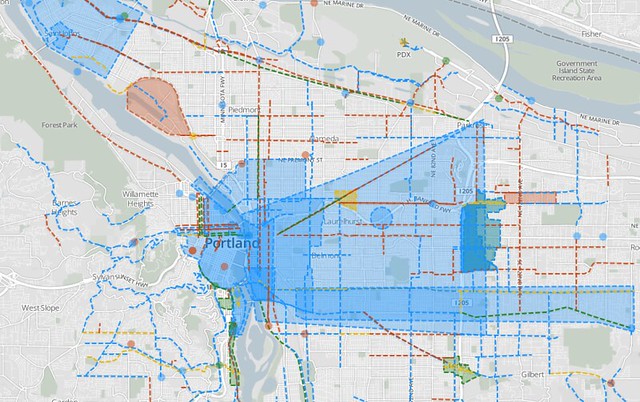
There were a handful of exceptions, which neither the Mercury or Oregonian found interesting enough to mention: $50 million to widen SE McLoughlin Boulevard to six lanes. $50 million for a new freeway ramp connecting Interstate 405 to the Ross Island Bridge. Not to mention $464 million in projects focused more exclusively on truck and rail freight to the city’s industrial areas.
An update to the city’s transportation project list is due in November. Rivera said that list will be much shorter than the current one, reflecting new projections that assume less gas tax revenue and more pavement maintenance.
Advertisement
Still, Rivera and Zehnder didn’t dispute the notion that the city is unlikely to ever again spend millions to, for example, add a traffic lane to Burnside by pushing its sidewalks into what once were storefronts, or try to revitalize Lents by building a freeway through it.
“We’re a built-out city,” Zehnder said.
What does the city see itself becoming? Here are some “before” and “after” images the city released Wednesday to illustrate its vision for NE Glisan Street at 72nd:
For SE 122nd at Division:
For SW Barbur near Hamilton:
Looking at these concepts and talking with Portland’s top planners, I couldn’t help but wonder why, if this is what city leaders say they want, all the talk from the Portland Bureau of Transportation bureau is that the streets must be safe. Certainly that’s true — there’ll be no increase in biking and walking if people don’t feel it’s safer — but biking and walking are already extremely safe in the parts of Portland expected to grow the fastest.
For this plan to work, increasing safety won’t be nearly enough. Non-car transportation will need to get much faster, much more comfortable and much more convenient.
Then I read the comments people had left beneath the Mercury’s coverage, which had emphasized the 7th/9th Avenue bike/walk bridge.
City planners certainly have a clear vision for the future. What’s less clear is that most Portlanders share it. If Portland weren’t likely to grow by 50 percent in the next 20 years, better biking, walking and transit might just be luxuries. But if people move to the city at the rate its economists expect, increasing car-lite transportation will be a necessity.
As this comprehensive plan moves toward public approval over the next year, its future may depend on whether more Portlanders can come to face those facts.


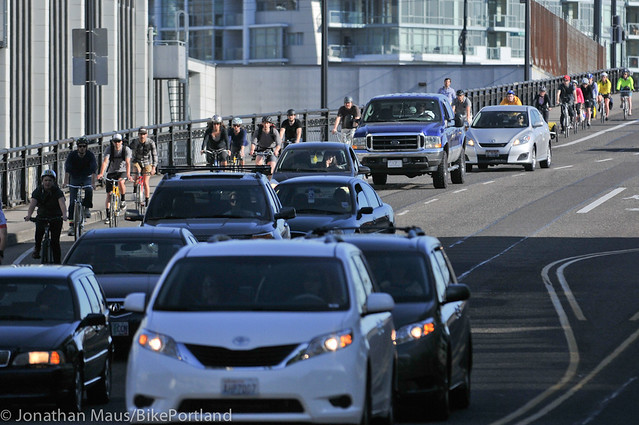

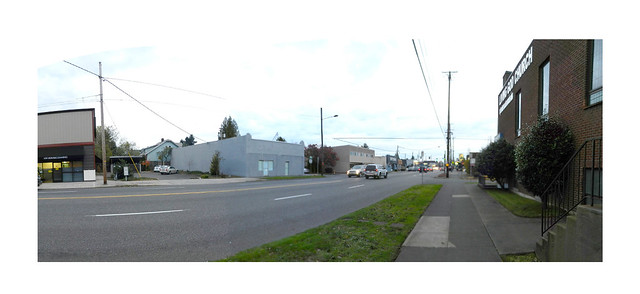
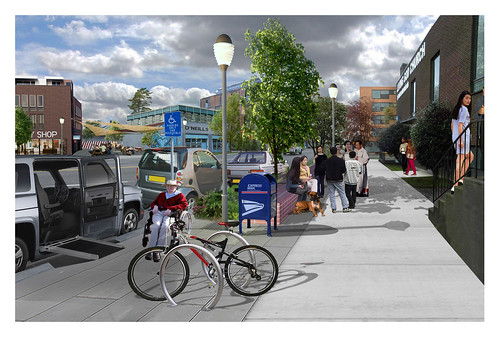
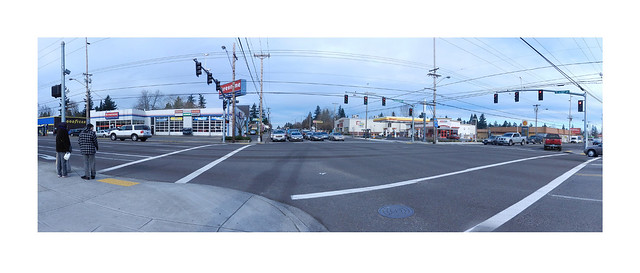
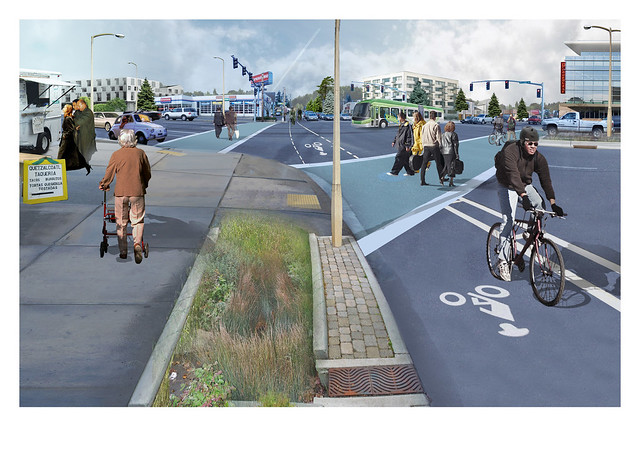
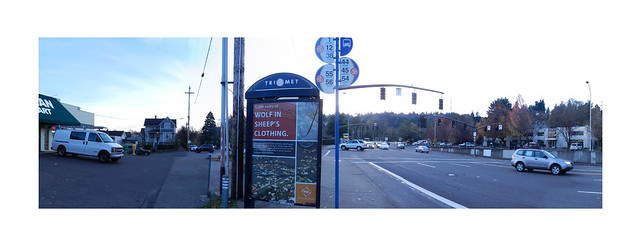
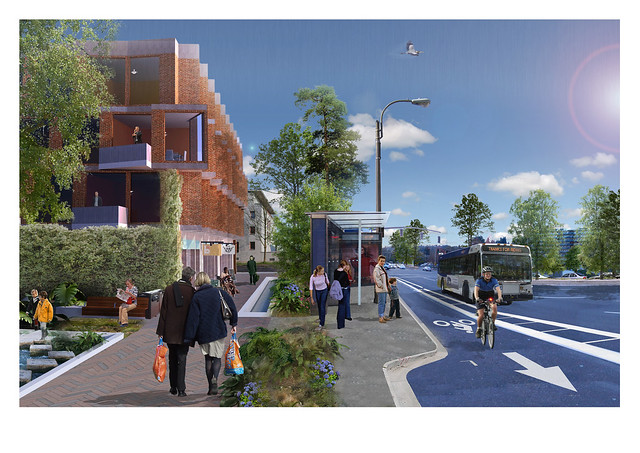

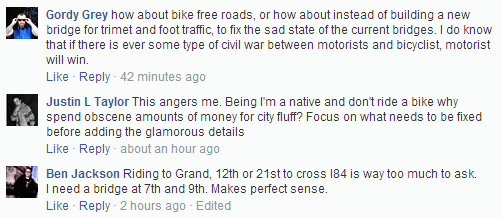
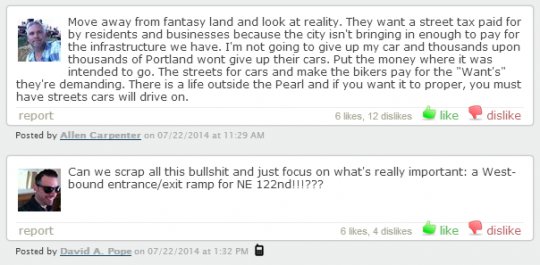

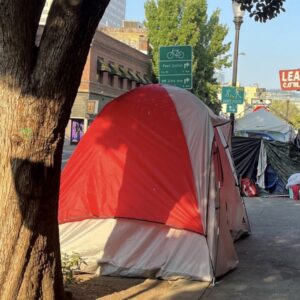

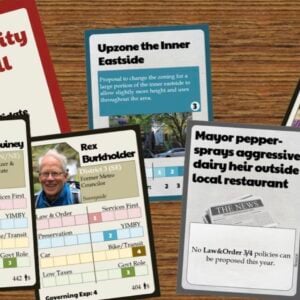
Thanks for reading.
BikePortland has served this community with independent community journalism since 2005. We rely on subscriptions from readers like you to survive. Your financial support is vital in keeping this valuable resource alive and well.
Please subscribe today to strengthen and expand our work.
Wow! I didn’t know that W Burnside’s odd storefronts are the consequence of adding another lane.
Crazy, huh? Looks like it was two more lanes, actually. http://www.cafeunknown.com/2006/08/hung-over-on-burnside-they-were-called.html
Quite the opposite here: http://www.sccgov.org/sites/rda/plans/ExpresswayPlan2040/Pages/expresswayplan2040.aspx
When I see hateful comments about bicyclists (especially regarding traffic), I ask those people to count the number of bicyclists they see stopped at the next light, then multiply that number by the length of a car and imagine themselves that much further back. What they’re really asking for is that less (other) people use the roads so they have more to themselves, and of course that goes against the principles of increased “growth” driving the revenues to pay for the infrastructure they also want.
Sad to see people don’t realize what “obscene” and “glamorous” amounts really mean when it comes to relative value in city and county budgets.
It’s worth noting that all the negative comments you’ve highlighted are from men. Assuming women make up approximately 50% of road/transit users, why are our voices marginalized? It may be because article comments are an unproductive aggro-dominated space, and women are busy getting shit done in the real world, which requires two-way communication and compromise.
Comment of the week material.
My Y chromosome has shrunk 3 sizes just now 🙂
There’s a sexist generalization if there ever was one….
Do a little research on what you’re talking about before patting yourself on the back for a snide, uninformed comment like this.
Maus- how about an article on this!
That about sums up the situation perfectly. 😀
If Portland is going to continue to be a livable city, we need city leaders that aren’t afraid of opposition. Per Steve Clark “…you can’t be afraid of opposition because without opposition you’re probably not doing anything. That’s your best barometer that you’re making a difference.”
Accept the fact that there are going to be loud-mouthed ***[word deleted by moderator]*** that live inside their own fantasy where they can continue to easily drive their cars into the middle of town in 15 years after a 50% population increase, and that those ***[word deleted by moderator]*** have even discovered the internet. They’ve already demonstrated that they don’t have the ability to plan for the future.
“$50 million to widen SE McLoughlin Boulevard to six lanes. $50 million for a new freeway ramp connecting Interstate 405 to the Ross Island Bridge.”
yikes, that’s horrible! McLoughlin is already too wide, fast, and dangerous… and I’ve never had a problem with traffic on it… if they tamed the road they might get more business than strip clubs, car lots, and big box stores; they might get a community…
the Ross Island bridge is already a bottleneck and doesn’t need more ramps… the 2 side ramps with stop signs that feed it from the west already encourage people to ignore the stop sign… we don’t need a real freeway connecting the bridge when we already have 3 suedo-freeways (Naito, Powell, Barbur) connecting it…
But the 405 – Ross Island ramp would take the commute time traffic off the 5th/6th and SW Broadway surface streets, which is a mess morning and night.
https://www.google.com/maps/@45.5070173,-122.6842526,18z?hl=en
Bingo. A 405 to Ross Island ramp is a good idea, and is something that will be needed when we eventually demolish the Marquam Bridge and the east bank freeway.
Despite the cost, and that it is purely a highway project, there are actual benefits to cyclists to the 405 ramp. This ramp removes the other ramps from what I understand, giving Lair Hill back some of its neighborhood. Also, it takes cars that would travel south on Barbur and puts them on I5 and Macadam south. If Barbur has a lower traffic, it may provide a better argument to create protected bike lanes there (before they start building any transit a decade or so from now).
Yes, that caught my eye as well. I lived in Milwhacky when I first moved here, and was just off Mcloughlin. Definitely $50-million to widen it is throwing money away needlessly.
Perhaps we should stage “The Day Without A Bicycle”.
Take Your Car to Work Day, Oct 1 – right after the Bike Commute Challenge wraps up. Transit riders with cars should participate, too.
This would be much easier to execute if Trimet’s drivers and train operators unions went on strike.
If we thought something like that would happen it would be the best time to bring the hammer down on a “no bicycles in Portland day”.
This is genius. Every single bike commuter should drive their car on that one day, Just so that everybody can feel *why* we invest in alternatative infrastructure.
“Every single bike commuter should drive their car on that one day”
Clever? Sure.
But let’s not forget that one in seven Multnomah Co. households doesn’t own a car.
The impact would definitely be felt. You can get a taste of this phenomenon when it rains hard during the summer… Notice how packed the streets (and transit for that matter) get? My theory is that congestion is worse during wet/bad weather in large part due to thousands of people deciding not to ride their bikes.
I really wish we would get going on these things.
As it is now, it is incredibly frustrating for every mode, at least in my experience. Driving sucks and traffic is increasing everywhere, mass-transit is not that great and stops too early at night, biking is kinda alright in a couple places, but off limits in too many places. Walking is still an unpleasant if not hair-raising activity in many areas.
It does none of us any favors to half-ass projects and pit each other against ourselves. We all want to get there relatively fast and comfortably, but that seems to be beyond the will of anyone at the city to do anything about. So we’re stuck this awful Frankenstein system that pisses everyone off.
low occupancy motoring has been in a decade long decline and, imo, this trend will only quicken in the coming decades. instead of improving low occupancy vehicle infrastructure we should be thinking about how to dismantle it and re-purpose it.
I lived here 20 years ago. It’s better now, much better.
Regarding the miles of unpaved streets and lack of sidewalks in some areas, I think people have fallen into an emotionally-fueled trap that was created by the media (mostly through the sensationalised stories of the unfortunate death of one child on such a street) and picked up by the city through the subsequent popular demand.
In reality, none of these sub-standard streets have more than a small trickle of traffic volume, and speeds are low enough that safety – even without sidewalks – is likely less of a concern than smoothly-paved neighbourhood streets. I grew up frequently visiting a lot of areas in East Portland with streets like these, and I always thought the rural feel – often with large Douglas Fir trees – was quite welcome.
There are most certainly busier streets that lack sidewalks in some sections, and the city should certainly fix those, but I find the abrupt push to spend millions on streets that have been unpaved for years to be troubling, especially when the city is begging for money. The money that will now be spent on such projects in the near future will be taking away from bicycle, pedestrian, and pavement maintenance funds with far lower return on investment in the form of marginally improved safety.
I’m guessing you live on a paved street?
Come on back in December with your walking shoes and road bike and we’ll see how welcome it is for you dodging mini lakes and ankle deep mud. And this is the kind of environment we are asking some of Portland’s kids to walk to school in (not to mention the people who just want to go for a walk around their neighborhood or walk their dog or bike commute to work). Some of these roads are almost forcing people to drive and is that really what we want?
There are certainly plenty of folks who live on these roads who are okay with them as is, what most of them are not okay with is that they pay the same tax rate as the rest of the city but have far less to show for it in local infrastructure and maintenance.
How many citizens have died walking on unpaved streets without sidewalks?
I don’t know?
But the city (and definitely PBOT) doesn’t do every single thing with 100% only safety in mind.
I thought livability was high on the priority list for Portland.
In the last two years, two school girls and a young woman attending college. But they were in Outer SE. These deaths would not have been tolerated in Ladd’s Addition. But don’t worry- Eastmoreland has been upzoned and it has beautiful sidewalks. So the Mayor is safe.
Were those streets unpaved? I think part of the point of the question was to make us think about the danger level of unpaved streets, as they discourage speeding.
Still, I’d rather have paved streets with sidewalks.
But there are plenty of streets in Portland that are both paved and don’t have speeding issues. Pavement does not automatically mean a street that gets speeding.
Look, the heartless city planners met their density quota by dumping a bunch of crappy multi-family buildings in an area without sidewalks/parks.
The outer Eastside wasn’t planned- it was abused. It was the planning equivalent of malpractice, and Eric Engrstrom admitted as much (while explaining they had no idea how to fix the planning disaster around SE 136th).
Pavement and speeding are necessarily linked, but it doesn’t take a rocket scientist to link the body count on SE 136th to the dreadful planning combining shoddy architecture and a failure to expand te infrastructure to welcome the new residents.
Nothing has changed in the planning mentality- they are just going to dump the unused unwanted density in an area with little political clout.
Right, but I was questioning whether Mamacita was answering the question that was actually asked by Chris I. Yes, there have been tragic and needless fatalities along streets with no sidewalks, but I don’t know whether either case cited in Mamacita’s answer happened along an unpaved road, which is the question that was asked. No argument from me that driver behavior and street safety depend on a myriad of factors, only one of which is street surface quality.
Stop lying. Those two girls were killed on a paved street without sidewalks. Because the streets were paved, they were hit by cars traveling at high speed; something not possible on pothole-filled unpaved streets.
So again, you’re saying all paved streets lead to speeding?
So we should just depave roads in Portland anytime someone wants to add speed bumps or reduce speed limits?
Not what I said. Paving an unpaved street without adding additional traffic calming measures will lead to increased average vehicle speeds. If the city can’t even fund paving these streets, I would imagine that they can’t afford speed bumps and roundabouts at every intersection.
They’re CHOOSING to not fund paving these streets.
PBOT estimates about $300M to pave all the cities unimproved streets. Certainly this is a big number, but not so astronomical as to not be doable in the next 20 years.
Chris, you are so rude.
I can’t apologize to someone that consistently misrepresents facts to forward their agenda.
Chris and Mamacita, you’ve both made your positions clear on this. Please do your best to avoid further assessments of one another – and please be civil when talking about these issues we all care about so much.
How would the sidewalks have prevented the crash?
Put aside for a moment that property taxes generally don’t pay for transportation projects. When the public pays for paving your street and your property value increases accordingly, are you willing to pay more in property taxes based on that higher value or is it just a windfall profit to you and your neighbors?
If it’s still the same rate as the rest of the city than that is more than fair. I’m not that convinced that paving unimproved streets is going to add a huge amount to the value of a home anyways.
Take SE 46th vs SE 48th (south of SE Malden). They are parallel streets: one is paved and one isn’t. The average home price is not vastly different from one to the other (according to zillow at least).
The fact that we are even having this conversation in a major city in the US in 2014 is just laughable.
You can’t have it both ways. You say you want a paved street, and list several good arguments for it, then claim that it won’t add value to the adjacent properties? Are you serious?
And I would argue the “livability” point you made above, unless you consider the ability to drive a car at 30+mph down a residential street “livability”.
The solution here is a combination of local improvement district and PBOT funds. 50/50 split. The local residents cover half, bonded over 10 years, and the city picks up the rest. The amount of money raised by the LID will determine if it is just a basic paving, or a street that includes sidewalks.
How is that having it both ways? I’m saying that I don’t think most people factor in basic city services (like paved streets and sidewalks and sewers) into estimated financial value of homes. For example I’ve never seen a house for sale in Buckman list as “has sidewalks and on a paved street”. “Livability” is a different metric. Sure the garden and trees I plant in my yard might not increase the bottom line on my house but they sure would increase its livability. I don’t consider safe and convenient sidewalks as a “perk”.
I mentioned nothing about driving 30+ mph (and there are plenty of paved residential streets in Portland that keep their average speeds well below 30).
Maybe I’m not understanding your argument.
You can call that a solution, but these roads are mainly located in the lower income neighborhoods of Portland. So even that 50/50 is a huge ask to residents (esp. considering many bought their houses before annexation for that much money or less).
My point is exactly that sidewalks are a “perk”. Houses with paved streets and sidewalks are worth more than identical houses without them.
You have a myriad of housing options in the Metro area. Most of them have sidewalks, some of them do not. There are neighborhoods out in Tigard that don’t have sidewalks, and there are some out in east Portland. You may not value sidewalks, but many buyers do. I bought a smaller house in a neighborhood with sidewalks because I value walking and active transportation. I have no sympathy for people that choose to rent or purchase a larger house in a neighborhood without sidewalks and expect the rest of us to pay for street improvements.
“Houses with paved streets and sidewalks are worth more than identical houses without them.”
You can spout this all you want, but do you have any data to back it up?
A home’s value has so many things tied into it that you can’t really pull out a concrete value for a paved street (and again, this is such a weird Portland anomaly that I don’t even think it is included when they run the comps. on your home (for instance I know there is a $5k difference for being on a quiet street compared to main street)), if there is any.
And again, most of these streets are in low income neighborhoods. So if you are low income you rarely will have a choice of buying a home with/without a sidewalk.
I should point out that I have both a sidewalk and a paved street in front of my house. Many in my neighborhood do not. I’m tired of seeing kids have to walk in the street to school because we have an incomplete network of sidewalks and streets (and because their parents don’t make a lot of money) and Portland should be embarrassed that they have the second most miles of unimproved roads in a major city in this country. This from the city that touts itself as a progressive city with great infrastructure. Clearly we’re not going to agree on this, so I guess I’ll just leave it with this great WW article on the subject.
http://www.wweek.com/portland/article-17460-dirt_roads_dead_ends.html
Jorgy,
There are a hundred influences on the price of a house near an unpaved street.
The objection I hear from the owners of unpaved streets is why they should pay for a public good that they do not get to fully enjoy? The owner of a new skinny house near Mississippi is the one who is benefiting from the infrastructure we all paid for- tax them more!
Kyle,
there are some small, residential streets w/o sidewalks and very low traffic, but your statement is misleading. SE 136th has a lot t4raffic, is a major n/s connector, and has intermittent sidewalk (in process of getting one-side of sidewalks). East Powell is another high traffic street lacking continuous sidewalks.
136th is a Neighborhood Collector, 9900 vehicles per day, 85th percentile of 34-36 mph in a posted 35 mph zone, at the Bush Greenway crossing, where new sidewalks have been installed and a rapid flash beacon crossing.
I grew up on a rural gravel road, that was off another rural gravel road, that was off a sidewalk-less paved rural access road. The lots were 1/10 acre, with just a couple 1/4 acre lots. All in all there were about 12 houses on our little 1 block long dead end street. Our household had to chip in to pay for road grading and new gravel once in the 10 years I lived there.
Right now I live next to the 1/2 block that is unimproved SE 86th Ct. It was regraded last year because the owner of the house across the way did it help the sale of the house along. It’s currently just as bad as it was before it was regraded.
Gravel roads in Portland aren’t like rural gravel roads because they see a lot more than the localized residential use. There’s a constant flow of cars through 86th Ct even with the big candy-strip blockade sign that indicates it’s not really a through road. It’s serving vehicles from beyond the block – delivery trucks, utility vehicles use it as a staging area all the time…
Yet, the three houses that border this street are expected to be 100% responsible for maintenance and/or upgrades?
Just like every other local service street in portland? why not?
not much mention in the report of rezoning areas around the new Orange line Max stops.
That actually bothers me a lot. Having affordable housing along the green line – particularly in the Morelands – would really benefit folks that work at some of the larger supported employment sites in the Milwaukie area.
meant to say orange line – not green line. I need my afternoon coffee.
Hasn’t Portland failed to develop the area around the Eastside Max & Lents? Lots of treeless weed-filled lots near the Max.
Does Portland own the property? I’m confused. I think what you are seeing is land speculation. Private owners decide when to develop those lots, not the city.
But the city can stop up-zoning sfh areas since the density can go where the city promised us it would go. TOD! TOD!
PDC owns most of it. So yes, the City owns a lot of land in that area of Lents.
if Portlanders can’t tolerate paying to fund these transportation improvements – not even a $140/year per household fee – then I expect the future in 2030 will be very different than what the Comp Plan envisions. Something like: no additional auto capacity, no additional transit capacity, no additional bike capacity, and no addtiional sidewalks either. But every household will have enjoyed their forty cents a day saved.
And the proposed street fee is not the only way to get this kind of money.
We’ll need the street fee AND many other funding sources too.
That doesn’t compute for me. Novick & Co. pretty much blew their chances of getting additional funding they know we need by putting all their rotten eggs in the Street Fee basket. No, they should have been pragmatic about the scale of the maintenance backlog, etc. and gone for the sensible, potentially bottomless, and above all fair pot of money which is the gas tax. Index it already (3x the asphalt index).
Remember that the downtown condo owners in the Pearl only pay 100 a year. That is the cost of one dog grooming session!
You broke the cardinal rule of the internet: don’t read the comments.
Is there any mention of the Sullivan’s Gulch trail?
Sorta. It was in the out-of-date 2006 city transportation project list, and therefore on the comp plan map. But it’s absent from the 2014 Metro regional project list.
The Sullivan’s Gulch Corridor is, as far as I understand, in complete limbo. Its point person within PBOT, former planning manager Paul Smith, has retired. The last time we’ve heard anything about it was 2012:
http://bikeportland.org/2012/02/15/visualizing-the-sullivans-gulch-corridor-67319
I would be very pleasantly surprised if this makes it onto November’s city list.
Make MAX service faster and more reliable. I take the MAX from the east side to Hillsboro occasionally to get to work but, it makes for a gruelingly long day given that it’s over an hour each way (that’s just the ride itself, getting to/from the stops adds additional time). Much of this is because the MAX operates on surface streets downtown and stops every 2 blocks.
Until they make trimet useful for something other than getting to/from downtown, it will not be used for anything other than getting to/from downtown.
Great point. I feel like it’s a chicken/egg scenario. Need more riders to run more trains and need more trains to attract more riders.
Would have been so much better if they had buried it downtown so it didn’t become as slow as the streetcar.
Yeah, there really needs to be a train that only has a few stops and feeds to other trains. Gateway, Downtown, Beaverton, Hillsboro/185th area. Encourage major employers to have Shuttle busses from those stations.
Precisely – there are far more ways to raise money than sticking low and middle class people and small businesses with the bill. I’d like to know how many people with incomes over 100,000 and larger corporations are dodging significant amounts of local taxes…
If you are paying a mortgage on a house in central Portland, 100K is not that much money these days. That’s just about the income of 2 married school teachers. Comparing them to a tax dodging corporation is just silly.
I”m assuming he mean $100k+ for one earner in Portland, which is still a good bit of money in a town like ours with its lower cost of living (for the West coast).
This is why I live in Portland.
Our city leaders get it, at least at a basic level. You can’t just build more lane miles for SOVs to deal with traffic. Where would the space come from? Would we demolish houses and businesses to widen Division, Powell, MLK? Space is constrained, so we need other options. The problem is that a significant segment of the population is willing to spend thousands of dollars every year, and hours every day sitting in traffic. It’s absolutely insane that people decide it’s acceptable to buy a house an hour away from their job, and our city should do nothing to support this lifestyle choice. All the cities that have accommodated this behavior by building more roads and freeways have destroyed their downtown regions and their livability. Portland is different.
“The problem is that a significant segment of the population is willing to spend thousands of dollars every year, and hours every day sitting in traffic.It’s absolutely insane that people decide it’s acceptable to buy a house an hour away from their job, and our city should do nothing to support this lifestyle choice.”
I’m guessing that you are fortunate enough to both live and work in central Portland, and are able-bodied enough to be able to choose to bike to work some of the time. You are either single or both you and your partner are lucky enough to both have central Portland jobs. Bravo to you.
Many people do not have a choice but to sit in traffic to get to their job. The economy is so bad and many of us are stuck with living in Portland and commuting to Hillsboro or Salem or Vancouver or vice versa. And what about families where the income earners find themselves in the old “7-10 split”? God forbid the city should help these people keep the economy going and eke out a living.
“Lifestyle choice”? – you have got to be kidding. Show me all these people who love commuting an hour or more a day.
I will agree with you that the city leaders “get it,” as far as catering predominantly to the central city. I’m more surprised than anything to read that they sometimes give money to annexed parts of the city and anything past se 39th. Services for the white and well-off as usual in Portland. Only one of the conceptual drawings above had non-white faces.
Portland leadership is to infrastructure what Reagan was to economics: trumpeting the trickle down theory to justify the status-quo.
Today, people can live in Hillsboro, Salem, Vancouver, etc instead of living in Portland and driving to those places. They could also take MAX to Hillsboro and ride a bike or e-bike or bus to work.
In 2030, if we (Portland, and Oregon, and the PacNW region) make the needed investments, there could be many more options. If MAX were extended over the river, Portland to Vancouver would be an easy commute. If we had a fast train system, Portland to Salem would be an easy commute and even Portland to Seattle would be feasible. (Even California is starting, fitfully, to work on their fast train project.)
However, this will require investment of a scale analogous to what was needed to build the freeway system for the previous, car-centric system. The projects in the Comp Plan probably total over $1 billion (I haven’t added them up, that’s a guess) for Portland alone. Regional high speed rail would be many tens of $ billions.
Technology will help. Self-driving cars may make car pooling commutes more practical. Telecommuting may become more accepted. But I think it will be unavoidable, that a major wave of investment in transit infrastructure will be needed.
Where will the money come from? Ultimately, fees and taxes on you and I. The future costs. Pay to play.
“Today, people can live in Hillsboro, Salem, Vancouver, etc instead of living in Portland and driving to those places. They could also take MAX to Hillsboro and ride a bike or e-bike or bus to work. …” John Liu
What percent of the people employed in those cities also live in the city where they work? If the residency opportunities in those cities are affordable, attractive and enjoyable, it obviously makes much sense for people to live 20 minutes or less from where they work.
People that may do so offer great potential for reducing the extraordinary load upon commute routes between cities. During commute hours, cars lined up bumper to bumper like tombstones on roads such as Hwy 217 in Beaverton, have been a daily occurrence for years.
Train service through Downtown Portland isn’t going to get any faster until subways are built.
I think many people would agree with Joe Zehnder, the city’s chief planner’s observation that Portland is “…a built-out city,”. Definitely doubtful that observation is anywhere close to unanimous, or that any seriously clear, viable idea of what to do to handle future transportation needs, is in many people’s minds.
In Beaverton with the in planning South Cooper Mtn development, the predicament threatens to be replicated, because there doesn’t seem to be good awareness of and commitment to devising transportation plans outside of conventional area strategies, that can provide well for congestion reduction objectives.
John,
There is a veiled suggestion to long term Portland residents that if they don’t like the changes imposed by a small group of technocrats, developers and active transit enthusiasts, they can move.
Time will tell who moves. The recall petition is something to watch as a barometer of just how angry the general population- esp. on the Eastside, gets. “Smart growth” seems to benefit the “smart money.”
Maybe Portland will wake up to that.
This is really well said, and while I also see Chris’ point, there are plenty of extenuating circumstances out there that sometimes necessitate commuting by car.
Times have changed from 30 years ago when lifelong employment was actually an option for some. Today people are bouncing from job to job and if you are tied down with owning a house or kids in school it is definitely not always practical (generally or financially) to sell and move closer to the other job, not to mention two income households where their jobs may be in different areas.
As pointed out above TRIMET is slow and not ideal for many, who would rather save 30 minutes and sit in that hours worth of traffic coming into Portland from Hillsboro, than spent 1:30 MAX/Biking it.
Now I’m not saying we should go out and increase lane capacity to accommodate these types of drivers or anything like that, but it’s so dismissive to just assume that everyone has the choices you have.
Suburbs without any employment centers nearby were everyone is forced to drive somewhere else for work, I have a little less sympathy for those folks.
SW Resident nails it: trickle down development.
Also, let’s be clear: the city planners get estimates wrong all the time.
It is in the best financial interests of developers to project that thousands of people will move to Portland and live as the builders want them to live: in tiny new apartments without air-conditioning or parking. Remember that those apartments are the most lucrative residential structures to build.
Frankly, given the planning disaster & density dumping in East Portland, i consider Joe Z. et al to be bad at planning, and deaf to what the average Portland resident wants. heck- the planners are betting on people not wanting kids!
Yes- we need to grow. But BPS will only chart the course that the developers want- because developers run the show in this town.
On the flip side, estimates of increased auto traffic on many routes have also been very wrong.
Everything is a choice. I am by no means loaded. I bought a small house that is centrally located and worked my ass off to fix it up to a livable condition. I could have spent the same money and gotten a 4 bedroom house an hour outside the city, as many do. No one is forced to buy a 4 bedroom house in Sherwood, they choose to because they like the space and the yard, and, apparently, don’t mind spending 500 hours per year sitting in their car. It just comes down to what you value in life.
Everything is a choice, but when it comes down to a choice between take a job that is an hour away or stay unemployed and possibly be forced to have your child skip meals the “choice” becomes a little more obvious.
I think people care about providing for their family more than the size of their house.
But to support living near where you work and working near where you live the zoning has to be dramatically overhauled. You can’t build huge blocks of flats at one end of town with retail below but no office space around and say “ta da! we did it!” This is going to require completely rethinking our patterns of development. Lots more 3-5 story mixed use and office blocks in places not downtown or the burbs.
“But to support living near where you work and working near where you live the zoning has to be dramatically overhauled. …” Andrew
Yes, the planning philosophy should be dramatically overhauled. Is there much of a market for the kind of community that would consist of people living within walking and biking distance from where they work? In our area, there doesn’t seem to be.
Everyday, freeways 217 and 26 on the West Side are clogged up during rush hours. Could be wrong, but it stands to reason that some numbers of the people commuting, are Portland residents in their motor vehicles, traveling Portland streets to make a connection with the highways for Hillsboro destinations of Intel or other big employers on the West Side. Portland’s problem with having with no more room for auto capacity on its streets, is spreading beyond its city limits.
“Is there much of a market for the kind of community that would consist of people living within walking and biking distance from where they work? In our area, there doesn’t seem to be.”
How can you say this? I think the vast majority of Portlanders would LOVE to have jobs within walking distance of their homes.If you moved Intel to somewhere in Portland, I think most employees would be overjoyed!
If you’re talking about Beaverton, then i have no idea.
“…I think the vast majority of Portlanders would LOVE to have jobs within walking distance of their homes.If you moved Intel …” daveness
Portland residents employed at Intel in Hillsboro, could move to Orenco. Thus removing these people from Portland’s daily commute would be a simple and logical way to help deal with Portland’s transportation needs.
I’m sorry I think we’re on different topics here. The original comment was more about moving jobs to places where people already live and want to live. I think you’re talking about building housing near the jobs that already there. I don’t know that that is going to work very well (How well is Orenco doing?).
Having jobs near where people work is exactly what Orenco was conceived as, and is about. What I gather, is that it is successful, but not nearly to the extent needed to have employees at area high tek plants not contribute in large part to daily commute congestion on the highways.
I have a friend in Beaverton who rides a bike recreationally, but he drives 1 mile to his job every day. Some folks are just hard to reach…
“is there a market for it” is a cop out question. Markets are not fixed, they respond to influences. Right now, yes there is a market for this kind of development, but without quibling we could agree that it isn’t large or large enough at this time, but that begs the question. Many people would want that kind of development if they had to pay the full cost of car ownership and road repair and parking without subsidies. If the city, rightly, invests money is cycling and mass transit and doesn’t unsustainably keep building 5 billion dollar bridges and freeways to subsidize exurban development then market forces will create the market for that kind of development.
The real test will be long (like 5 decades long) term success. Would Portland be an appealing place to live with a growing population and a vibrant economy over that time period or would everyone move to Houston and Dallas?
New urbanite advocates will obviously argue (effectively I think) that this is exactly the kind of city that will be successful and sustainable over the next century.
“…Many people would want that kind of development if they had to pay the full cost of car ownership and road repair and parking without subsidies. …” Paul in The ‘Couve
The full cost of car ownership and road repair and parking is part of the cost of living. Motor vehicles, not bikes, are by far the majority means of transportation in the city. Motor vehicles, not bikes, are the predominant means of transportation upon which most people and the economy depends.
I like to refer to things the shape of development happening on the west side, in part because here, but also, because unlike Portland, it’s not yet built out. I’m not sure, but parts of Vancouver, or Tualitan, Wilsonville, may have similar circumstances. Washington County, for example, has the potential to realize the kind of ‘work, live’ community Andrew suggested.
I think, ‘Is there a market for it?’ isn’t a cop out question, but an essential, basic question to be asking as part of community planning. It seems obvious to me that this is exactly one of the questions developers, loan institutions, local officials and so on are asking. The kind of communities they plan, are most likely a fairly clear indication of the answer to the question, that to date, they’ve come up with.
Seems to me that developers want to build what they think they can sell. If there’s little indication people are going to buy something, developers aren’t going to want to build it.
“It’s absolutely insane that people decide it’s acceptable to buy a house an hour away from their job, and our city should do nothing to support this lifestyle choice.”
Hey, my house is an hour away from from my job—unless I really crank it, then I can make it in 53 minutes. However, my house used to be ten minutes away from my job (by car), then my job moved an hour away (by car & MAX), then it moved 35 minutes away (by bike), now it’s an hour away (by bike, or 30 minutes by car)… The best-laid plans don’t always work out unless you’re willing to move every time you get a new job.
I don’t understand why there’s so much downzoning in the Comprehensive Plan. A good swath of inner NE between Williams and MLK – going from R2 to R2.5. Means any multi-family development is smaller – looking at duplexes rather than triplexes and fourplexes.
Eastmoreland and the n’hood north of Reed – going from R5 to R7 (meaning 7,000 square feet on land area per housing unit – which means traditional eastside 50 x 100 lots are too small for these areas). That pretty much enshrines those areas’ suburban character forever. Doesn’t Portland want density and population growth? How do we do that with extensive downzoning?
Actually there is not a whole of downzoning (or upzoning). Most of these areas are already developed. The loss in future development capacity is relatively small.
The Eliot change from R2 to R2.5 is intentional since the Neighborhood Association wants to save the historic structures that are generally on 2000 square foot lots. These are the few remaining neighborhoods that have a significant amount of pre 1900 working class homes. This seems fair to me since they already are accepting significant amounts of density on the main corridors. Eastmoreland, wanted the change for the same reason, except they do not have ANY density even though they are very near the new MAX line.
I should have said 4000 square foot lots. R2 allows for demolition and lot splitting, R2.5 does not allow to split the lot. Developers can still demolishing the 1890’s structure and build something bigger, but this may stem some of the demolitions.
“is intentional since the Neighborhood Association wants to save the historic structures”
this is just a euphemism for the upper class nimby desire to reduce construction of new units that house the lower classes. (a form of modern feudalism.)
The “lower classes” are moving into East Moreland and Eliot (Mean housing price of $646K and $363K, respectively)?
Lot splitting (with new skinny houses) is just profitable for developers. It isn’t changing neighborhood demographics. Most of the skinny houses around me (granted a lower income neighborhood) are actually more expensive than most of their neighbors).
i do believe people (and families) who cannot afford a half million dollar mortgage would move to east moreland if higher density housing became more available (in residential areas). rezoning might also allow the city to build low income housing and re-introduce a little socioeconomic and ethnic diversity.
If you don’t add housing capacity, mean housing price will become more expensive. San Francisco is a classic example, and is one of the least affordable places to live in the world. You seem to think that lot splitting makes housing more expensive. Explain how that works on a macro-scale?
The situation in my neighborhood was not a good fit for this specific discussion. I’m sorry to include it.
I was trying to say that I don’t think lot splitting in East Moreland is ever going to reduce housing prices there to get the kind of economically diverse population that I’m guessing spare is looking for. I think in East Moreland’s case, lot splitting there is just going to take a single expensive house and replace it with two expensive houses. I don’t really know that East Moreland even has enough lots to split that would make much of a density impact on the area.
The fantasy about lot splitting in Eastmoreland somehow creating lots of low-income housing is baffling.
Suppose a developer buys a large lot in Eastmoreland. As vacant lots are not exactly common there, this lot has a house on it, so lot plus house costs let’s say $600K. Demolish the house, split the lot, and build two narrower houses, construction and financing and sales cost of $250K for each, so cost of each narrow house is now $550K and it has to sell for $650K to make the return on investment worth it.
How exactly did this create low-income housing?
“Eastmoreland and the n’hood north of Reed – going from R5 to R7 (meaning 7,000 square feet on land area per housing unit – which means traditional eastside 50 x 100 lots are too small for these areas). That pretty much enshrines those areas’ suburban character forever.”
Our wonderful Mayor just happens to live in Eastmoreland, don’t ya know. Coincidence? I think not. Let the masses be packed in like sardines. We, however, will expand our footprint. And when it is convenient, I will claim WA residency for tax purposes and Oregon residency for voting purposes.
Do as I say not as I do, people. And keep quiet about it.
Anyone see the greenway proposals in the urban design framework? http://www.portlandoregon.gov/bps/article/497442
Pretty snazzy. How long can we wait for these? 3 million for the 70’s bikeway seems like chump change. I don’t mind a street fee if it will deliver that. Dedicated paths crossing the city would be world class.
“Actually there is not a whole of downzoning (or upzoning). Most of these areas are already developed. The loss in future development capacity is relatively small.”
100% wrong.
Tell that to the folks in “already developed” neighborhoods in Portland where skinny houses are now all the rage thanks to rezoning to R2.5. There are lots of large lots in Eastmoreland that could be split up for skinny houses. Hypocrisy at its finest.
More evidence of a corrupt planning process. Mayor Hale’s neighborhood is upzoned, and then density is dumped on SE Foster, where the plan is to tear down the industrial spaces and put up more apartments and bars! Apartments and bars!
The job outlook for Portland is not good- especially with so many eggs in the the tech basket. Tech is boom and bust. The next bust will be ugly.
People will not be able to afford those apartments on North Williams.
The new designation of “Civic Corridor” is meant to allow for multiple uses. It still allows for employment, but ALSO allows for multiplexes and multiple stores.
I have been intimately involved in the planning process for our neighborhood that includes some significant “neighborhood mixed use” increased density. At least in our neck of the woods, the city planners have been very helpful, concerned about displacement and sincere.
SE Foster has industrial spaces that deserve the same protection that we see in the Central Eastside. Also, parks and playground are in short supply. The narrow side streets will be overwhelmed by the no-parking apartments. We don’t have enough police coverage for this relatively high crime stretch. Bus service isn’t great.
Also- the city is depriving the neighborhood of design controls. We have cool old buildings and there is potential for a more preservation, two story approach. But no- Joe Z. has decided that only rich folks can own homes in PDX and that all new buildings will be modern and too small for a family.
SE PDX is much more car friendly and family-oriented than downtown- but the city never asks about our real values- the city couldn’t handle the truth.
Isn’t the central eastside currently being slowly picked apart to make way for housing development?
Yes- and it needs to stop. How can we eliminate spaces for employers and then have enough jobs to go around? It reminds me of the old saying “fighting for peace is like (f-wording for virginity.”
Let us never forget that the parking crater around IIkea could have housed Laika or Nike. The Portland Plan is incoherent, so devlopers and planners pick through the mess and pick out certain goals
(shopping near transit!) even though the moves conflicte with other objectives (leveraging proximity to airport to attract big employers).
Naturally, we ended up with boring big box stores, tons of unused parking and not enough jobs. Good work, BPS!
Do you mean the Central Eastside Industrial District? There aren’t THAT many jobs there to begin with. According to this map http://www.reconnectingamerica.org/assets/Uploads/PortlandJobClustersSmallDots.pdf , it looks like there may be more jobs in the Pearl, which is a considerably smaller area. If the Central Eastside can add jobs and housing at the same time like the Pearl apparently did, I don’t see why that’s a bad thing. Sure, the Pearl has software, restaurant, shop, and personal-service jobs now rather than industrial jobs now but they’re still jobs and probably have a similar average income to the old industrial jobs.
If you mean the Central Eastside like the mid-southeast Foster area, I don’t think there are that many jobs there either, except for the Foster industrial area between 100th and 120th, which is not being picked apart for housing as far as I know.
Many of those old storefronts are in legal limbo because they were grandfathered even though they were “non conforming properties.” If a storefront lapses for more than three years being an active storefront…under CURRENT zoning….then it ceases to be allowed as a storefront. This legal limbo creates an untenable situation making it impossible for the owner to get financing unless the property conform to current zoning.
The new zoning fixes this, and allows these non-conforming properties to be legal. The city is NOT taking away neighborhood design controls. The design standards have not been written yet, and there is a committee based out of Division street activists that is working on a neighborhood toolbox that can be used for neighborhoods to help design future development that fits in with the scale. As far as reusing old storefronts…..we REALLY need to update our zoning code to encourage reuse instead of demolition, but that is another issue. So is that of park space.
Thanks for a polite and informative response!
SE Foster actually *does* have an industrial sanctuary/employment district (in Lents, SE of I205), and the plans are not proposing any changes to that.
We need protections closer in- from Mac’s radiators to Rollaway.
Of course, the flourishing trade at the end of Foster is- the sex trade!
Let’s build no parking apartments over the jack shacks so the dancers are close to work/johns.
Seriously- thanks for your comments. I know that you have studied these FoPo issues.
‘The new designation of “Civic Corridor”’
in other words undesirable arterial “corridors” where renters/lower class folk could theoretically be clustered so that twee residential property values continue to increase.
Hence why we need to update our code to encourage reuse of old structures and building on to with additions/ ADU’s/ Duplexing. Right now any house can have only ONE ADU (and it can not be a converted old garage sitting in the back yard for a myriad of reasons) One of the tools we need to use to increase affordability and density should be allowing for duplexing anywhere and muliplexing corner lots. Right now, corners can be duplexed but if you are zoned single family…you are stuck with it.
We will increase our population by 2.3rds over the next generation (Thank you to 200 years of western migration, climate change and smart urban growth management)…..we need to make room in the city or else everyone will be forced to live in shoe boxes in Gresham.
So you’re saying we shouldn’t put higher density around our busier streets?
I am saying that the original plan- TOD near Eastside Max- needs to be taken seriously.
Also- FoPo density puts density in with no guarantees of new parks, trees etc. We already have slow police response time, and the addition of new residents in an area where 10% of the residents are drugged out/insane etc- there will be problems.
So- FoPo density is a repeat of past disasters.
Also- FoPo density puts density in with no guarantees of new parks, trees etc.
how many fancy schmancy new parks are there in central portland over the past 7 years? and how many have been constructed east of 82nd?
“…There are lots of large lots in Eastmoreland that could be split up for skinny houses. …” m
Continue with your suggestion as to how splitting up large lots in Eastmoreland and putting skinny houses on them would help meet Portland’s transportation needs. To where would people from that location get to jobs, and how do you propose they get to those job locations if not by motor vehicle? In ways that are as practical, efficient, and comfortable as motor vehicles?
There’s a good chunk of Eastmoreland that’s going to be in easy walking distance of the new Bybee station on the Orange line. In my opinion, that section should be significantly upzoned (allow more density) rather than downzoned (allowing less density) as proposed in the draft Plan. That would help us get a better return on the Portland area’s significant investment in the Orange line MAX.
You’re asking the BikePortland comments section how people in a close-in Portland neighborhood should get to work without a car?
Justin, yes. From those neighborhoods, what are the sites of high paying jobs within walking or riding distance that people will actually ride or walk to rather than drive their cars? Jobs paying what high tech out in the suburbs pays, that people are comfortable supporting a family on.
People drive beyond what most people would consider reasonable bike distance, because they recognize that’s what they’ve got to do to have the standard of living they’re after.
Well, to mention just a few sectors that come to mind, there are software jobs downtown, medical jobs at OHSU and the other hospitals, and industrial jobs on the Springwater Corridor and on Swan Island. All of those areas are a doable bike ride from Eastmoreland, and OHSU and downtown will have very good transit access from western Eastmoreland once the Orange Line is complete. Sure, Washington County has seen a lot of job growth in the past decade. But Portland still has a lot of jobs and I think has seen considerable job growth over the past few years. Downtown is still the densest employment center in the area.
As to wages, I don’t know what you consider “enough to be comfortable starting a family on.” But I do know plenty of people starting a family off of their Portland jobs.
The tram helps, and so will the Orange line will help to make the job locations you mention, realistic destinations from Moreland. Though some, committed fit people likely will, most people aren’t likely to walk or bike there. As to wage required to support a family, I’ll just make a general thought that probably, a minimum of 20K/yr for a two adults and a child is needed to somewhat comfortably provide for that size family.
$20K seems low to me, it just barely squeaks above the poverty line for that size family which is $19,790 http://aspe.hhs.gov/POVERTY/14poverty.cfm (and in my opinion the poverty line, indexed to three times the cost of food ever since the 60’s, has not kept up with changes in the economy that have made food relatively less expensive and housing and transportation relatively more expensive).
But regardless, if you’re setting the bar anywhere close to that low, there are tons of such jobs within carless striking distance of western Eastmoreland. Downtown Portland, OHSU, and the Lloyd District add up to a huge job cluster. http://www.reconnectingamerica.org/assets/Uploads/PortlandJobClustersSmallDots.pdf
And I think you’re more pessimistic about the propensity of people to bike than I am. It’s 4.7 miles from central Eastmoreland to Pioneer Courthouse square. That’s a relaxed half-hour bike ride, and once the 20’s bikeway is complete it’ll almost all be on designated bikeways. Lots of people can do that, especially if they live in hopefully low-parking multifamily, and there’ll be the Orange Line as an alternative if they don’t want to bike on a given day.
I know the figure was low and I purposely chose it for that reason. I said the figure I suggested was a minimum. Obviously, to raise a family, people want a better wage than 20K, which is why they get in their car and drive out to Hillsboro and other places far beyond walking or biking distance.
I’m not pessimistic, but, realistic about people’s willingness to ride some distance to get to jobs away from their neighborhood. Sure, some people will ride the distance, rain or shine, hot or cold, day or night. Most in our part of the world won’t.
A hypothetical scenario: If Portland were somehow able to devise a workable plan to locate, in say, SE Portland, somewhere in the 40’s to 60’s, a company campus the size of Intel’s main plant in Hillsboro, what percent of the people employed at said plant, might choose to live within walking or biking distance from that workplace?
“A hypothetical scenario: If Portland were somehow able to devise a workable plan to locate, in say, SE Portland, somewhere in the 40′s to 60′s, a company campus the size of Intel’s main plant in Hillsboro, what percent of the people employed at said plant, might choose to live within walking or biking distance from that workplace?”
With cheap gas still available on every corner, not so many.
After cheap gas dries up and blows away, A LOT.
Insane? Maybe not totally–it’s a matter of affordability and the free market has failed. The state needs to use as heavy a hand as necessary to keep housing affordable, property rights be damned.
If you call bicycle infrastructure “fluff” I urge you to take a trip to Los Angeles and let us know why you do not live there. Maybe post while you’re sitting in the parking lot they call freeways? Second, take a look down and let me know if you can see your feet?
Sustainable development and mitigation is about changing sociatle norms (the things we do without thinking). Adding lanes, roads, and on ramps may increase the ease of driving temporarily, which eventually increases the amount of cars, which then causes even more traffic and an even greater need for what? ….more lanes, roads, and on ramps. Induced demand is common practice in large cities and has a tract record of not only failing miserably, but also creating other social and economical issues as well (think about housing prices and demographics of neighborhoods near high traffic roads and on ramps.). Portland has proudly remained “weird” through their growth by learning from other cities mistakes. Odds are good the easiest fixes are not solutions at all, but prolonging immediate problems for future generations. I am proud to say I am part of a community trying to better itself with a long tern agenda in mind.
With regards to the population growth I would expect most people, knowing about Portland’s bike reputation, will self-select themselves into this area. The ones that already love to bike will try to move here (like me) and those that prefer to drive should already know about the city transportation priorities.
Can’t say Portland sounds all that appealing in 15-20 years…we’ll be nothing but apartment buildings and congestion. Riding MAX is pretty joyless now as it is.
Yep, let’s bulldoze a few more neighborhoods so we can build more freeways. Can we start with your house?
Overall I found this article encouraging, but Rivera’s statement is a big disappointment.
“People who are driving today and want to keep driving, more power to them, and they can still do that,” city transportation spokesman Dylan Rivera said Wednesday. “But we have to acknowledge that growth is still coming and we have to figure out how to accommodate that.”
There comes a time when you need to call a spade a spade; recognizing when we’ve overdone it and have to back off, change course. But saying more power to those who want to keep driving in 2014(!) is not in the least bit helpful. In fact it is asinine.
As for the second sentence about growth being inevitable, that too is a crock. Alternatives to Growth Oregon (AGO) was dedicated to dissecting this notion, and I thought they did a fine job of it.
http://www.agoregon.org/page34.htm
Dylan Rivera said we had secured a bike share sponsor. His creditability is shot.
Is it at all possible that they did have a sponsor lined up at the time, and it later fell through?
Nope. Kaiser Permanente’s spokesperson said that KP has never committed to sponsorship. See the Portland Mercury’s article. Steve Novick committed a felony when he signed the Connect Oregon grant application. I am sorry to be blunt, but lying on a grant application is criminal fraud, and the amount of money in question (2.5 million) is serious. Trust me, Novick did something dumb in plain view, and it will come back to bite him. If Novick had something to clear his name- he would bring it out. sadly, his own quotes to the press suggests that he knowingly made and adhered to a false statement.
I have noticed LOTS of opinions and comments here, yet when I went to add my opinions to the Comprehensive Map Ap to be part of the public record VERY few people have commented about anything.
http://www.portlandmaps.com/bps/cpmapp2/#q1
Maybe some of the anonymous commentators on here who want these active transportation projects to move forward and support this plan should comment on the map so the city can hear you?
Much of the increased density in these main corridors is designed on a European model to try to turn as many neighborhoods as possible into a “20 minute neighborhood” where most of your trips can easily be done on foot. Bikes of course will have to be a major part of the equation. Much of the decrease in density in deep East Portland is due to school overcrowding and lack of services. There are some issues with slides and safety that led to these designs. Decreases in destiny around the SE Harold/17th Street is because that MAX stop is not being built, in other neighborhoods it is because the neighborhood associations requested them to try to stem the massive number of demolitions of the older housing stock. Some of the ideas are good, others are bad.
As someone who is a land use and transportation chair for a Portland neighborhood the city is very responsive, assuming you work under the assumption that people ARE going to move here and we ALL have to make room for them. I noticed that almost everything we requested in our neighborhood letter has been included on the map. Though, not ALL of the transportation projects are included citywide.
I would encourage everyone who is a Portland resident and wants to see us become a world leader in building out an “active transportation retrofit” of an American Automobile City to comment and be part of this city record.
I know in the days of the Internet actually attaching your REAL NAME to an opinion is SCARY, but anonymous comments only go so far. If you want to support this model, then COMMENT ON IT.
Thanks for the gentle scolding! I ‘m not sure I even noticed previously that you could leave comments in the Comprehensive Plan Map App, but now I have!
You are welcome. It is quite annoying having to type your info in everytime, but it is fairly easy once you get the hang of it.
They want to do all of this and they can’t even fix a pot hole in front of my house? Ha
Did you call 823-SAFE, or 823-BUMP?
Everything is a choice. I am by no means loaded. I bought a small house that is centrally located and worked hard to fix it up to a livable condition for my family. I could have spent the same money and gotten a 4 bedroom house an hour outside the city, as many do. No one is forced to buy a 4 bedroom house in Sherwood, they choose to because they like the space and the yard, and, apparently, don’t mind spending 500 hours per year sitting in their car. It just comes down to what you value in life. If people cared more about spending time with their families than the size of the house they own, you would see more small homes and apartments built closer together, and fewer large lot homes.
Kind of like the rest of the civilized planet!! I’m still baffled people get suckered into a 2k sq foot house when they really will never use that much space. They’d be able to live just as well (well, better actually cuz’ they’d likely have more money in their pockets) if they got 1k-1400 sq feet.
Housing and residential zoning in America is just completely insane.
“well, better actually cuz’ they’d likely have more money in their pockets) if they got 1k-1400 sq feet.”
I agree with your general point, but it is worth pointing out that over sixty percent of US households are now one- and two-person affairs. Surely those (the majority) could do very nicely with less than 1,000 square feet, no?
122,000 new households. Average cars per household is pretty close to 2. I usually figure ~100 sq ft to store a single car. That adds up to about 0.88 square miles in new car storage.
At 60 mph, a 4 second following distance is 352 ft. With 12 ft lanes you have 4,224 ft per car. Assuming 5% of those cars are on the freeway at any given time, you need 1.85 sq miles of freeway to accommodate them.
So that adds up to about 2.73 sq miles of parking and freeway to accommodate those new cars.
This is a silly exercise, but I think it gives you a decent order-of-magnitude estimate of the space requirements. Does Portland have a couple square miles of vacant land in the city limits to devote to parking and freeways?
Alternatively, a space in a parking garage costs $17,533 to construct. You wouldn’t have to use all that land if you put those cars in parking garages, but you’re also talking about a $4.3 billion investment.
10′ x 20′ to store a car in a garage. On street space is 8′ x 20′, so 160-200 SF per car.
Typical Portland. Says it’s going to start eating healthy while also buying bulk twinkies.